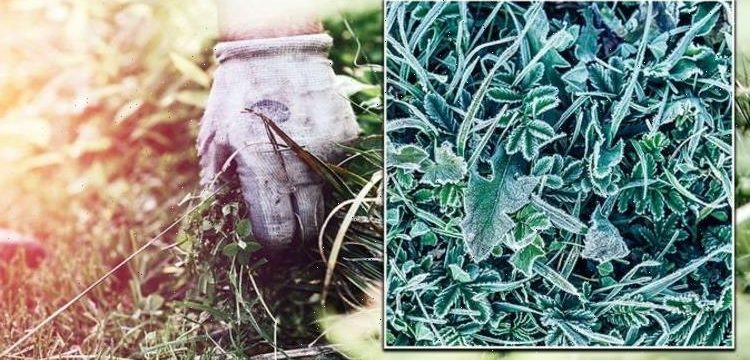How to remove crabgrass from your lawn
We use your sign-up to provide content in ways you’ve consented to and to improve our understanding of you. This may include adverts from us and 3rd parties based on our understanding. You can unsubscribe at any time. More info
Mowing your lawn is usually advised against during the winter months. Experts warn the damp and cold weather conditions can even be “dangerous” for both gardeners and their lawns. However, though your grass may be dormant, winter weeds could strike at any time.
Weeds can run on annual, biennial or perennial life cycles which can make them difficult to control.
Annual winter weeds germinate during the autumn and winter months, flowering in spring and then disappearing before summer.
But this is not the last you will see of them, as these pesky plants will only return again following the chilly season change
With most gardeners taking the winter season off from their horticultural habits, it can be easy to miss weeds popping up until it is too late.
This is why experts recommend keeping an eye out for five weeds in particular.

Poa annua
Poa annua, also known as winter grass, is a weed that has a distinctive appearance, often growing in clumps and spreading quickly.
The weed is typically a lighter shade of green than turf grass, and blossoms seedbeds which can be very noticeable.
Winter grass seeds germinate when the temperatures drop during the autumn months.
One plant can produce hundreds of seeds that can remain dormant in the soil of your garden years.
DON’T MISS
Why mowing your lawn in the morning may be ‘dangerous’ [WARNING]
The four factors that can slash how much your home is worth by £40k [INSIGHT]
Barack Obama: Inside former President’s property portfolio [PICTURES]
Though this weed tends to die out in the heat of summer, by that time, turfgrass is weakened and can be easily reinfected more winter grass when the cold temperatures return.
According to experts from GardeningKnowHow, the key to getting in control of your winter grass is through preparation and maintenance.
During the summer months, it is vital you keep your lawn healthy.
The experts state: “Water deeply but infrequently to help turfgrass develop long, healthy roots, but don’t water more than absolutely necessary.
“Turfgrass can withstand a little drought but winter grass will be challenged by dry conditions.”
Should you come across winter grass, it can be easily pulled thanks to its shallow roots.
The experts also recommend using pre-emergent herbicides drink the autumn and winter months.

Hairy bittercress
Hairy bittercress can be found in gardens throughout the winter months, and can actually be foraged for foods.
Most often this weed springs up towards the end of winter and continues to grow in spring.
Hairy bittercress is an annual weed and is one of the earliest to sprout and form seeds.
The best chance of stopping the spread of the weed is by controlling it early in the season.
Gardeners who have an abundance of plants should keep a close eye out, as it can easily hide away in your flowerbeds and shrubbery.
Prevent it from invading your turf by encouraging good grass growth in the late summer and autumn.
Experts from GardeningKnowHow warn that pulling out the weed might not be enough.
They state: “Pulling out hairy bittercress weed usually leaves the root behind. The plant will re-sprout from healthy weeds and the problem persists.”
Instead, use a long slim weeding tool to dig down and fully remove all plant material from the ground.
Get the latest three-day weather forecast where you live. Find out by adding your postcode or visit InYourArea
Henbit
Henbit is considered a winter annual, typically sprouting in patches beneath trees and shrubbery where grass already has a had time growing.
Henbit plants often have green or purple coloured square stems, and their leaves are round or heart-shaped.
The seeds of the weed sprout in the autumn or early winter.
During mild or warm days in the winter, the young seedlings will grow and then go dormant as temperatures drop.
However, this is enough to prepare it to emerge fully when the spring sunshine arrives.
A good defence against henbit is to ensure you have a thick lawn, leaving little room for weeds to grow.
If you do notice any weeds emerging, it is vital you find and control the plant before it flowers in spring.
According to Lisa, an expert from The Practical Planter: “Like any garden weed though, the most effective strategy is to do the back-breaking work of hand-pulling every henbit or any other unwanted plant you have in your garden or flower bed out by hand.”
Herbicides can also be used to kill henbit.
Source: Read Full Article
